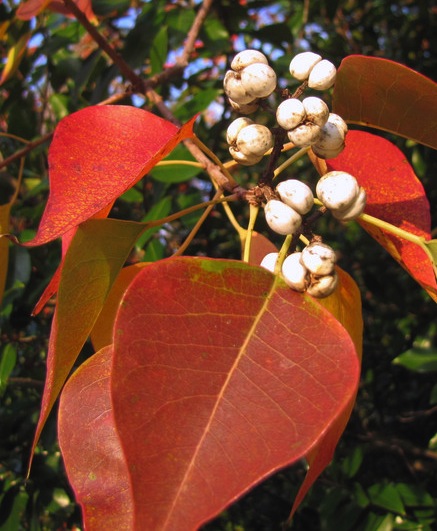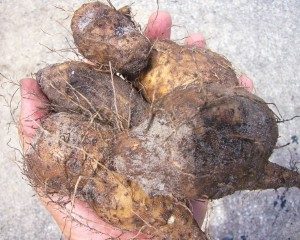During a class this weekend I noticed the Chinese Tallow trees are blossoming. The tree poses a challenge. It has an edible fat and a toxic oil. The question is how to easily separate the two. And if “easily” is the wrong descriptor then how can it be made worth a forager’s while?
The tree is an invasive species locally so finding a use for it would help the environment. Also as a source of fat it could literally be a life-saver in time of need because humans cannot survive without fat. In fact one can readily see the fat (also called wax.) It just doesn’t render easily.
Each seed has a thick coating of highly saturated fat, one reason why the species is also called the popcorn tree because when in fruit it looks covered by popcorn. By all reports the outer coating is edible and has been used to make candles, hence calling it wax. In fact the tree was imported from Asia by Ben Franklin specifically to start a candle-making industry in the South. As a saturated fat the outside is very solid at room temperature. Inside the seed is a liquid oil called stillingia. It is toxic to humans.
The “wax” is supposed to melt at 104 F. I’ve tried frying the fruit. The outer coating of fat stays solid. I’ve tried boiling. No luck. My readers have tried broiling — the seeds exploded — and micowaving, they got softer but did not melt. In China, reports Merriwether of Houston Edibles, they are reportedly softened the fruit in boiling water than scraped over a fine grater with 0.03-0.5 centimeter holes (Merriwether is a scientist.) Sounds like a great way to grind down ones fingertips. A third reader has a daughter who used it for a science project. Here’s what they did.
First they bought a hand-operated oil expeller. They cost about $150 on the Internet. (I’ve been trying to get some of the companies to give me one to review but without success.) They put the entire fruit through the press which also heats the material. Out comes a liquid mass that upon cooling has the solid saturated fat on top and wax on top and the oil on bottom. The student went on to make candles out of the “wax” and used the oil in a lamp. She won three science fairs and two scholarships. Way to go!
The next question we ask is whether the “wax” and the oil will sufficiently separate so the wax can be used as food? Also is it just as stubborn to melt even after being processed this way? My last question would be how digestible is it? The invasive species certainly has a lot of potential. You can read more about the Chinese Tallow tree here.
Fall is not the only time to harvest wild yams. We typically use obvious air bulbils in the fall to locate the vine often with large edible roots. But we can also locate smaller, edible roots this time of year as well. You look for the telltale square vines and pairs of opposite leaves. However, early in the season it can be a little tricky because young vines often haven’t developed pairs of leaves yet and will have singular leaves until older. However, the stem is square and the vine has what is called a Z-twist. That is at eye-level it twists from your lower left to your upper right, like the diagonal mark on the letter Z.
During class this past Saturday in Longwood it took only a few minutes to dig up several small yams, 20 ounces of roots in total that can be used like potato. They are perfectly stored and well-hidden from most eyes. In the fall one can find roots from five pounds shaped like a two-liter bottle to easily 30 pound or more. To read more about the Winged Yam go here.
After Sunday’s foraging class I visited herbalist Emily Ruff et vir for a wander around their fertile back yard and machinate about plants. It’s amazing what can be grown in a suburban back yard if you apply some knowledge and thought to it. They invited me to lunch but usually after class I avoid eating to help burn off some of that extra avoirdupois age silently packs on. After walking for four hours my body starts to tap into that fuel tank around my waist (some guys are working on six-pack abs, I’m trying to reduce the keg…) But when they offered me pickled Stachys floridana roots I could not say no. Absolutely wonderful: Crunchy, delicious, and a feast for the eyes as well. I would have easily begged for the recipe had Emily not promised that it will be posted on her website soon. When she does that relished repast will be resurrected here. Pickling is a fantastic way to preserve these delightful roots which already have a radish-like texture. Should they decide to go commercial with the product I even have a name for them: Staykles. To read more about Stachys floridana click here.
The fir tree called the Easter Hemlock (Tsuga canadensis) has edible parts. Young needles are used to make a tea and the inner bark is edible as well. The tree is also quite threatened and down to 1% presence in some places compared to when Europeans first arrived. One reasons is many areas of the country are overpopulated by deer and their urine is threatening the tree’s future. Deer like to nibble on the Eastern Hemlock. They know a good thing when they taste it. Their urine, however, is high in nitrogen and hemlocks like low nitrogen soil plus they are slow growing. Trees such as the sugar maple, however, like high-nitrogen soil so they are moving in and outgrowing hemlocks. (Don’t confuse the tree called the hemlock with a green herbaceous plant call the hemlock, which is deadly.) And while permaculture is a related speciality and not my area of competency it might be nice to have a cute deer or two in the back yard to recycle “garden waste” and make nitrogen…
Upcoming foraging classes: Saturday, June 22nd, Florida State College, south campus, 11901 Beach Blvd., Jacksonville, FL 32246, 9 a.m. Sunday, June 23rd, Colby-Alderman Park: 1099 Massachusetts Street, Cassadaga. Fl. 32706, 9 a.m. To see the full schedule go here.






As cute as those little bambis are, I’d like to wring everyone of their little necks, and their parents’! After four years of hard work and much expense, I finally experienced the joy of watching about 40 rose bushes thrive — for the first time (poor soil was the major reason). This spring, the deer have decided to nibble nearly daily on the rosebuds, and once those are gone, on the new growth. Yesterday, my neighbor, who is out at 5 a.m. for her daily run, saw two huge deer on our street, and two large and three young ones one street over. We’re being taken over! Help! (I live near the ICW north of St. Augustine.)
Can you try attaching brightly colored bits of gift wrapping ribbon to the limbs? I notice a few people around here in our wooded neighborhood attach reflective fluttery bits of plastic ribbon on their house siding or deck rails. It looks a bit Barbie doll and tacky, but it apparently works for scaring woodpeckers and nesting birds away. Perhaps the deer would be scared away too.
I live in rural S. GA, and deer are EVERYWHERE! I have a small fruit tree orchard which they love. I cut ladies black panty hose into about 16 inch pieces, tie one end shut. I purchase Irish Spring soap in a six pack and cut each bar into four pieces. I place a piece of soap into each hose and tie them onto my fruit trees. In my 1/4 acre garden I simply distribute the soap around the garden. The deer hate the smell because it is like humans. They stay away.
I live between St. Augustine and Daytona Beach, many deer here also, in fact in the middle of the afternoon, they start their grazing. If you dont want to put up fences and bird netting ( i know….ugly), find some strongly scented plants to inter plant among the roses, like scented geranium , mints and there are a few more, i have the lemon Marigold, very tiny blooms but very strong odor. I have also ordered Garlic stakes that clip in to the plants, those work pretty good, deer hate strong smells . But i can sympathize with you, i have grape vines that i envisioned picking my own grapes again, for 2 years every time they put on new growth, deers came, so this year i finally got around to putting wire around it, hate to because it is hard to prune around the wire, but if i want them to have a chance to grow, i guess i have to have wire protectors. deers are beautiful to watch but they sure take a toll on your plants.
Hi Deanne,
Would you please forward this message to your reader who’s daughter refined oil and wax from Chineese Tallow Tree and won scholarships and prizes for her efforts. I would love to speak to her about appearing on my T.V. show, ‘Cooking Wild’. I also extend a standing invitation to anyone with outdoor foraging and survival skills of any kind to contact me if interested in sharing your expert advice on the show. Thanks.
I think you can do it yourself at the bottom of the Chinese Tallow page.
How nice to see Emily in your always enjoyable newsletter. I can’t imagine a better green spirit guide on my herbal journey. Loved the class at Red Bug Slough. Thanks for all you do Deane!
With all the deer problems, it sounds like more people need to eat venison,
Deer have become a ‘weed’–Eat The Weeds?